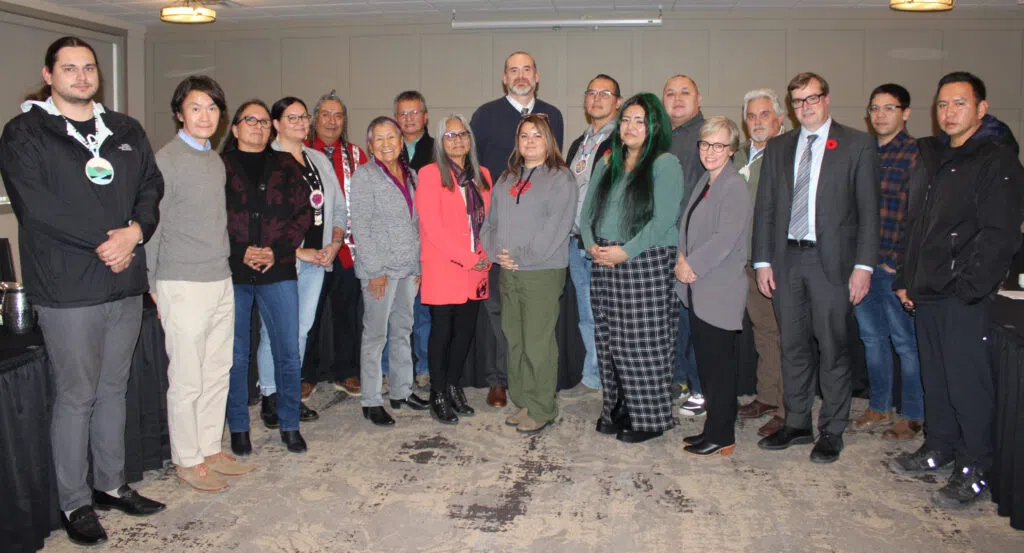The chair of the Ktunaxa Nation Council is happy a path toward a study on transboundry water contamination from coal mining in the Elk Valley appears to finally have a clear path forward.
Kathryn Teneese is hopeful the announcement that the US and Canadian governments have agreed to request an International Joint Commission study on contamination in the Elk and Kootenay Rivers is the begging of restoring the local waterways.
Teneese says the agreement could not have been reached without the Ktunaxa Nation’s deep involvement in the process.
In November the local Indigenous nation called on both federal governments to work through their impasse after missing a deadline to reach an agreement in principal by last summer.
The IJC study will ensure experts and knowledge-holders will work collaboratively to develop an action plan to mitigate and reduce impacts from coal mining in local waterways.
See a statement from the Ktunaxa on the agreement between the two governments below:
Leadership of the transboundary Ktunaxa Nation—the Confederated Salish and Kootenai Tribes, Kootenai Tribe of Idaho, and the Ktunaxa First Nations of ʔakisq̓nuk, ʔaq̓am, Yaqan Nuʔkiy, and Yaq̓it ʔa·knuqⱡi’it—are encouraged to announce that the United States and Canada, in partnership with the Nation, have finally agreed to ask the International Joint Commission (IJC) to study and make recommendations to address the mining pollution in the Elk and Kootenai/y rivers through a joint reference. (Statement from the United States here and Canada here.)
The reference asks the IJC to convene a Governance Body that will develop an action plan to reduce and mitigate the impacts of mining pollution in the Elk-Kootenai watershed. This body will be comprised of impacted governments with jurisdiction and legal obligations in the watershed.
The reference also establishes an IJC Study Board that will bring experts and knowledge holders together to share knowledge and data in a coordinated, transparent process. The Nation expects this work will achieve a common understanding of pollution within the watershed and the impacts it is having on people and species, which will in turn support recommendations to the Governance Body and the public.
“This is an important first step in addressing the serious pollution problem in the Kootenai Watershed, and I am glad to see that the U.S. and Canada are finally taking their commitments to Indigenous peoples, the environment, and the international Boundary Waters Treaty seriously,” said Gary Aitken Jr., Vice Chairman of the Kootenai Tribe of Idaho. “For decades, mining has impacted our waters, our people, and our resources. While we were seeking action, things moved far too slowly, and the federal government looked the other way. We are finally starting a process where there can be collaboration, trust, and transparency. Ktunaxa said we would not stop until there was an action plan, and we look forward to seeing that through to ensure the real work of healing the river is achieved.”
Ktunaxa leadership has been urging Canada and the U.S. to address water pollution in Ktunaxa homelands for over a decade.
In March of last year, Prime Minister Trudeau and President Biden committed to “reach an agreement in principle by [summer 2023] to reduce and mitigate the impacts of water pollution in the Elk-Kootenai watershed in partnership with Tribal Nations and Indigenous Peoples, in order to protect the people and species that depend on this vital river system.” (Full statement available here.)
The summer deadline passed with no action from the federal governments. This prompted Ktunaxa leaders to call upon both federal governments to meet in ʔamakʔis Ktunaxa (Ktunaxa Territory) in November 2023 to work through the impasse and agree on a path forward. At that meeting, the governments collectively committed to find a solution—through a reference to the IJC—by the end of the year. After nearly three months of intense negotiations, the governments reached agreement, and almost exactly a year after the Prime Minister and President’s statement, the reference has finally been issued to the IJC.
“For too long, the U.S. and Canada have stood by while our waters suffered,” said Michael Dolson, Chairman of the Confederated Salish and Kootenai Tribes. “We are encouraged by the federal governments’ change in direction and the progress that was achieved when we all worked together these past months. We will continue to work tirelessly to restore our rivers and the fish and wildlife that depend upon them. We’re at the beginning of what will likely be a long process, one that will require sustained effort from all governments involved.”
Kathryn Teneese, Chair of Ktunaxa Nation Council, said: “It is good to see that the U.S. and Canada—in partnership with the Ktunaxa Nation— have started collaborating effectively on this issue and are working toward meeting their commitment to reduce and mitigate the mining pollution in the Kootenai/y watershed. However, just as this agreement could not have been reached without the deep involvement of the Ktunaxa Nation, future progress will require meaningful inclusion of Ktunaxa knowledge and stewardship. We are setting the foundation for an IJC, and we welcome the IJC Commissioners’ involvement in this issue. We hope this is the beginning of a collaborative, transparent, and effective process that will restore the waterways in the heart of ʔamakʔis Ktunaxa that are vital to the Ktunaxa ʔakⱡsmaknik (people).”
Full tri-lateral reference and proposal here:
Reference for the Elk-Kootenai/y Watershed | International Joint Commission (ijc.org)
– Article includes statement, photo and files supplied by Ktunaxa Nation Council









Comments